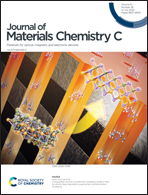Highly thermostable fluoride nanocrystal-in-glass composites (NGCs) for mid-infrared emission†
Abstract
Nanocrystal-in-glass composites (NGCs), comprising custom-tailored nanocrystals (NCs) embedded in a transparent glass matrix, have recently attracted more attention due to their ability to manipulate deterministic control over the phase, morphology, and luminescent performance of the embedded NCs. However, the heat-induced interaction between NCs/NCs or NCs/glass is still a significant challenge across the entire fabrication process, from NC optimization to NGC co-sintering. Such undesired interaction proposes a high demand for the thermal/chemical stability of NCs. Hence, we employed a protecting shell to expand the compositional selection range of embedded NCs. As a proof-of-concept experiment, we aimed to incorporate thermally unstable NaYF4:Er3+ NCs into a tellurite glass for efficient mid-infrared (MIR) emission. A robust SiO2 shell was introduced on the NC surface, which, on the one hand, provides strong protection to suppress phase transition and crystalline coarsening during thermal annealing, and, on the other hand, serves as a sacrificial shell to minimize the interfacial reaction between the active NaYF4:Er3+ NCs and glass during co-sintering. The successful demonstration of ∼2.7 μm MIR emission in NGC materials doped with NaYF4:Er3+@SiO2 NCs indicates the feasibility of this core-shell design.



 Please wait while we load your content...
Please wait while we load your content...